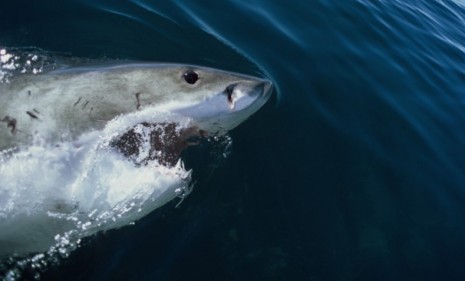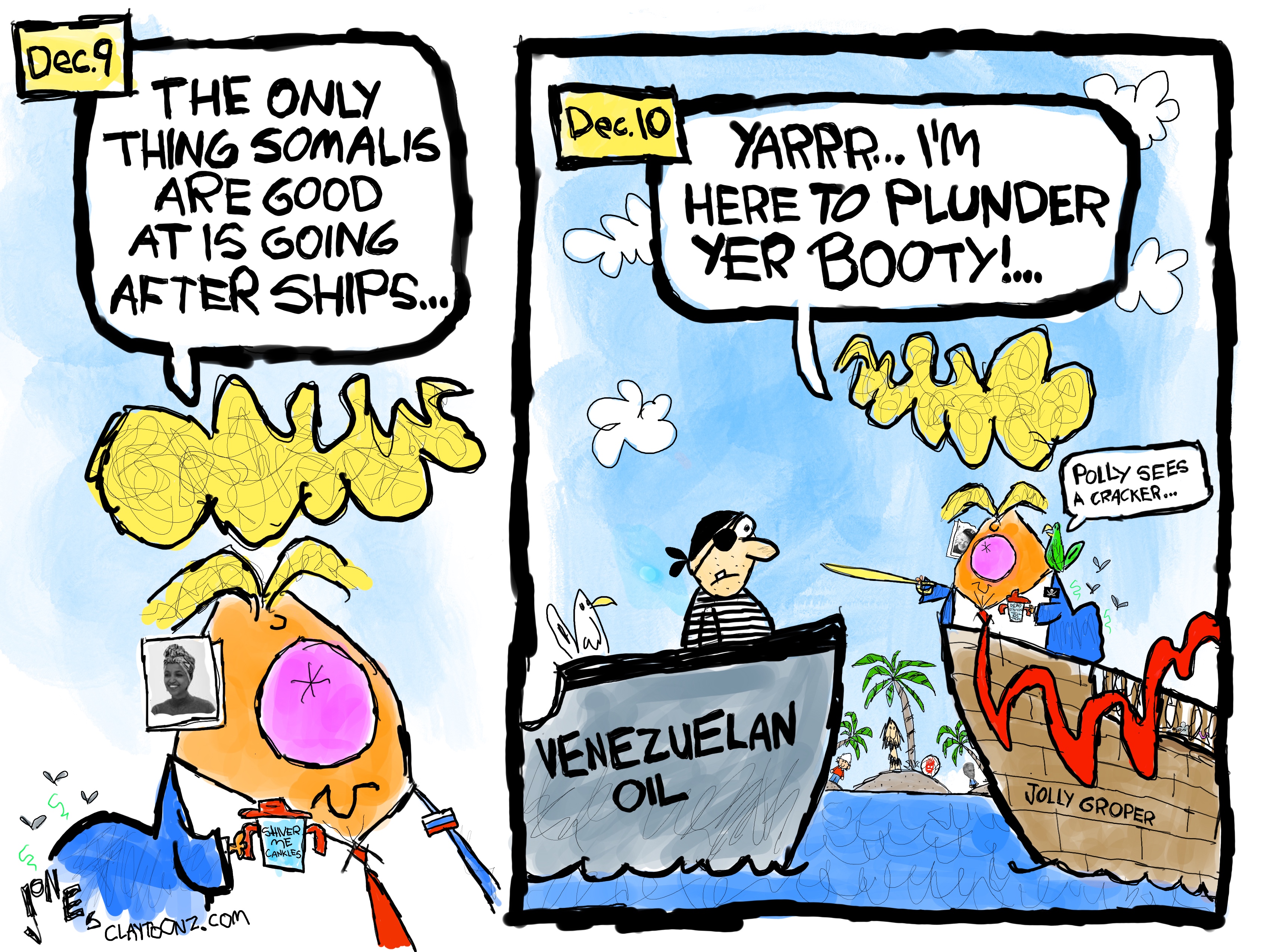The last word: Endurance at sea
No food. No water. Sharks everywhere. In this excerpt from Laura Hillenbrand’s new book, "Unbroken," three U.S. airmen refuse to surrender

ALL HE COULD see, in every direction, was water. It was June 23, 1943. Somewhere on the endless expanse of the Pacific Ocean, Army Air Forces bombardier Louie Zamperini lay across a small raft, drifting westward. Beside him lay his tail gunner, Francis “Mac” McNamara. On a separate raft, tethered to the first, lay a third crewman, pilot Russell Phillips, known by the others as Phil. Their bodies, burned by the sun and stained yellow from the raft dye, had winnowed to skeletons. Sharks glided in lazy loops around them, dragging their backs along the rafts, waiting.
All of the other men from their crew were dead. Their plane had gone down in the ocean 27 days earlier, and the three survivors had been adrift ever since, surviving on rainwater and the few birds and fish they could catch. The rafts were beginning to deteriorate into jelly, and gave off a sour, burning odor. The men’s bodies were pocked with salt sores, and their lips were so swollen that they pressed into their nostrils and chins. They spent their days with their eyes fixed on the sky, singing “White Christmas,” muttering about food. No one was even looking for them anymore. They were alone on 64 million square miles of ocean.
On that morning of the 27th day, the men heard a distant, deep strumming. Every airman knew that sound: pistons. Their eyes caught a glint in the sky—a plane, high overhead. Zamperini fired two flares and shook powdered dye into the water, enveloping the rafts in a circle of vivid orange. The plane kept going, slowly disappearing. The men sagged. Then the sound returned, and the plane came back in view. The crew had seen them.
The Week
Escape your echo chamber. Get the facts behind the news, plus analysis from multiple perspectives.

Sign up for The Week's Free Newsletters
From our morning news briefing to a weekly Good News Newsletter, get the best of The Week delivered directly to your inbox.
From our morning news briefing to a weekly Good News Newsletter, get the best of The Week delivered directly to your inbox.
With arms shrunken to little more than bone and yellowed skin, the castaways waved and shouted, their voices thin from thirst. The plane dropped low and swept alongside the rafts. Zamperini saw the profiles of the crewmen, dark against bright blueness.
There was a terrific roaring sound. The water, and the rafts themselves, seemed to boil. It was machine-gun fire. This was not an American rescue plane. It was a Japanese bomber.
The men pitched themselves into the ocean and hung together under the rafts, cringing as bullets punched through the rubber and sliced effervescent lines in the water around their faces. The firing blazed on, then sputtered out as the bomber overshot them. The men dragged themselves back onto the one raft that was still mostly inflated. The bomber banked sideways, circling toward them again. As it leveled off, Zamperini could see the muzzles of the machine guns, aimed directly at them.
Zamperini looked toward his crewmates. They were too weak to go back in the water. As they lay down, hands over their heads, Zamperini splashed overboard alone.
A free daily email with the biggest news stories of the day – and the best features from TheWeek.com
Somewhere below him, the sharks were done waiting. They bent their bodies in the water and swam toward the man under the raft.
THE BULLETS SHOWERED the ocean in a glittering downpour. Louie could see them popping through the rubberized canvas, shooting beams of intensely bright tropical sunlight through the raft’s shadow. Louie pushed against the bottom of one of the rafts, trying to get farther down to be outside the bullets’ lethal range. Above him, he could see the depressions formed by Mac’s and Phil’s bodies. Neither man was moving.
The current clutched at Louie, rotating his body horizontally. He looked down at his feet and noticed that one of his socks had slid halfway off and was flapping in the current. Then, in the murky blur beyond it, he saw the huge, gaping mouth of a shark emerge out of the darkness and rush straight toward his legs.
Louie recoiled, pulling his legs toward his body, away from the shark’s mouth. The shark kept coming, directly at Louie’s head. Remembering a lesson from survival training, Louie rammed his palm into the tip of the shark’s nose. The shark flinched, circled away, then swam back at him again. Louie waited until the shark was inches from him, then struck it in the nose again. Again, the shark peeled away.
Above, the bullets had stopped coming. As quickly as he could, Louie scrambled back into his raft. Phil and Mac were lying together in the fetal position. Neither man had been hit. Louie looked up and saw the bomber circling back.
Phil and Mac played dead, and Louie tipped back into the ocean. As bullets knifed the water around him, the shark came at him, and Louie bumped its snout and repelled it. Then a second shark charged at him. Louie hung there, gyrating and flailing his arms and legs, as the sharks snapped at him and the bullets came down. The moment the bomber sped out of firing range, he pulled himself back into the raft. Phil and Mac were still unhurt.
Four more times the Japanese strafed them, and four times Louie returned to the water and fought off sharks. Each time he emerged, he was certain that Phil and Mac would be dead. Impossibly—though there were bullet holes all the way around the men, even in the tiny spaces between them—not one bullet hit either of them. Finally, the bomber flew off.
One of the rafts had been slashed in two. A bullet had struck the air pump and ricocheted straight across the base of the raft, slitting it from end to end. The men were sardined together on what remained of Mac and Louie’s raft. The canvas was speckled with tiny bullet holes, and each time one of the men moved, air sighed out and the canvas wrinkled a little more. The raft sat lower and lower in the water. The sharks whipped around it, surely excited by the bullets, the sight and smell of men in the water, and the sinking raft.
As the men sat together, exhausted and in shock, a shark lunged up over the raft wall, mouth open, trying to drag a man into the ocean. Someone grabbed an oar and hit the shark, and it slid off. Then another shark jumped on, and, after it, another. The men gripped the oars and wheeled about, frantically swinging at the sharks. As they turned and swung and the sharks flopped up, the motion forced air out of the bullet holes. Soon, part of the raft was completely submerged.
Working as fast as they could, the men hooked up a hand pump and began reinflating the raft, striking at the sharks all the while. Louie grabbed the raft’s patching kit and began sealing holes. As Louie patched, sharks lunged at him from behind, where he couldn’t see them, but each time, Mac and Phil smacked them away. Hour after hour, through sunset, darkness, daylight and exhaustion, they pumped, patched, and hit the sharks. At last, the raft was patched and mostly reinflated. The sharks stopped attacking.
DAYS PASSED. THE men grew weaker, slowly starving to death. Louie studied the sharks, thinking. One day he came up on his knees by the raft wall, watching a shark that was roughly 5 feet long. He roused Phil and shared an idea. They were going to try to catch the shark.
They had a little bait on the raft, probably the remains of their last bird, and the raft’s meager provisions kit contained some fishhooks and a spool of line. Phil hung the bait on a hook and strung it into the water at one end of the raft. At the other end, Louie knelt, facing the water. Smelling the bait, the shark swam toward Phil, orienting itself so its tail was under Louie. Louie leaned far overboard, plunged both hands into the water, and grabbed the tail. The shark took off, yanking Louie into the ocean. Louie bolted back into the raft so quickly that he later had no memory of how he had done it.
Soaking and embarrassed, Louie rethought the plan. He had underestimated the shark’s strength, failed to brace himself properly, and foolishly allowed the shark’s tail to stay submerged, giving it water to push against. He settled in to wait for a smaller shark.
In time, a four-footer arrived. Louie braced himself as Phil dangled a baited hook in the water. When the shark swam for the bait, Louie clapped his hands around its tail, heaved it up, and dragged the animal aboard. As the shark twisted and snapped, Phil grabbed a flare cartridge and jammed it in the shark’s mouth to prevent it from biting them. Louie took the provision kit’s pliers and stabbed the handle through the animal’s eye. The shark died instantly.
The men had been taught that the only part of a shark that was edible was its liver. Louie took a signaling mirror and used its edge to cut into the shark. After a great deal of sawing, he pulled out the liver, and the three men shared it. For the first time since breakfast on May 27, they were all full.
The bounty didn’t last. Using the same technique, the men were able to catch one more small shark, but after the second kill, word seemed to get around: No more small sharks came near the raft. The men’s stomachs were soon empty again.
All three men had lost a staggering amount of weight, but Mac had shriveled the most. He was now little more than a wrinkled mummy, perhaps 60 pounds. The men caught one last albatross, tore off its head, and allowed the blood to run into Mac’s mouth. It didn’t revive him.
On the evening of the 32nd day, Phil and Louie lay down around Mac, put their arms around him, and went to sleep. Sometime in the predawn hours, Louie was lifted from sleep by a deep outrushing of air, slow and final. He knew what it was.
When the sun came up, Phil wrapped Mac’s body in something—probably a remnant of the ruined raft. Louie wanted to give him a religious eulogy, but didn’t know how, so he recited disjointed passages that he remembered from movies. Then he gently slid Mac into the water. Mac sank away. The sharks let him be.
THE STRAFING HAD given Louie and Phil one important piece of information. They thought the bomber must have come from the Gilbert or Marshall islands, to the west, the direction in which the raft was drifting. Estimating the bomber’s takeoff time, cruising speed, and range, they calculated that the strafing site was probably about 850 miles away from the bomber’s base. This would mean that the men had drifted well over 1,100 miles, and were traveling more than 40 miles per day. Extrapolating, they made educated guesses as to when they’d reach land. Phil guessed it would be the 46th day; Louie guessed the 47th.
If their guesses were right, they’d have to somehow stay alive on the raft for two more weeks. No one had ever drifted anywhere near as long on an inflated raft and lived to tell about it. Even more unnerving was the thought of their destination. The Marshalls and Gilberts were held by the Japanese, who were notorious for murdering prisoners of war.
The two starving men slumped in the raft, watched the featureless horizon, and drifted ever deeper into enemy waters. Their journey had only just begun.
From the book Unbroken by Laura Hillenbrand. ©2010 by Laura Hillenbrand. Reprinted by arrangement with Random House, an imprint of The Random House Publishing Group, a division of Random House, Inc. All rights reserved.
-
 Political cartoons for December 12
Political cartoons for December 12Cartoons Friday's political cartoons include presidential piracy, emissions capping, and the Argentina bailout
-
 The Week Unwrapped: what’s scuppering Bulgaria’s Euro dream?
The Week Unwrapped: what’s scuppering Bulgaria’s Euro dream?Podcast Plus has Syria changed, a year on from its revolution? And why are humans (mostly) monogamous?
-
 Will there be peace before Christmas in Ukraine?
Will there be peace before Christmas in Ukraine?Today's Big Question Discussions over the weekend could see a unified set of proposals from EU, UK and US to present to Moscow